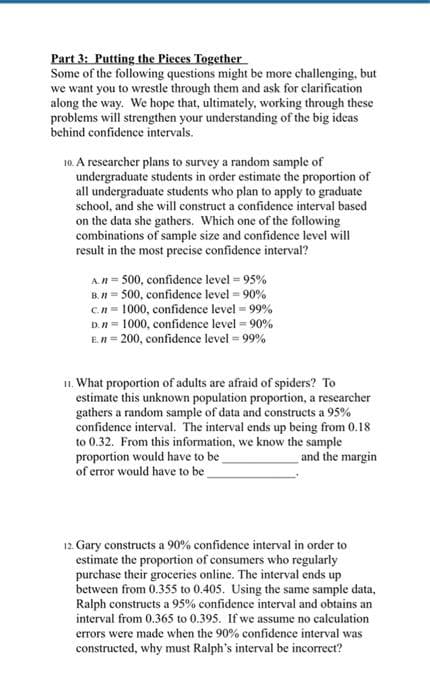on the data she gathers. Which one of the following combinations of sample size and confidence level will result in the most precise confidence interval?
on the data she gathers. Which one of the following combinations of sample size and confidence level will result in the most precise confidence interval?
Glencoe Algebra 1, Student Edition, 9780079039897, 0079039898, 2018
18th Edition
ISBN:9780079039897
Author:Carter
Publisher:Carter
Chapter4: Equations Of Linear Functions
Section: Chapter Questions
Problem 8SGR
Related questions
Question

Transcribed Image Text:Part 3: Putting the Pieces Together
Some of the following questions might be more challenging, but
we want you to wrestle through them and ask for clarification
along the way. We hope that, ultimately, working through these
problems will strengthen your understanding of the big ideas
behind confidence intervals.
10. A researcher plans to survey a random sample of
undergraduate students in order estimate the proportion of
all undergraduate students who plan to apply to graduate
school, and she will construct a confidence interval based
on the data she gathers. Which one of the following
combinations of sample size and confidence level will
result in the most precise confidence interval?
A.n= 500, confidence level = 95%
B. n = 500, confidence level = 90%
c.n= 1000, confidence level = 99%
D. n 1000, confidence level = 90%
E.n=200, confidence level = 99%
11. What proportion of adults are afraid of spiders? To
estimate this unknown population proportion, a researcher
gathers a random sample of data and constructs a 95%
confidence interval. The interval ends up being from 0.18
to 0.32. From this information, we know the sample
proportion would have to be
and the margin
of error would have to be
12. Gary constructs a 90% confidence interval in order to
estimate the proportion of consumers who regularly
purchase their groceries online. The interval ends up
between from 0.355 to 0.405. Using the same sample data,
Ralph constructs a 95% confidence interval and obtains an
interval from 0.365 to 0.395. If we assume no calculation
errors were made when the 90% confidence interval was
constructed, why must Ralph's interval be incorrect?
Expert Solution
This question has been solved!
Explore an expertly crafted, step-by-step solution for a thorough understanding of key concepts.
Step by step
Solved in 2 steps

Recommended textbooks for you

Glencoe Algebra 1, Student Edition, 9780079039897…
Algebra
ISBN:
9780079039897
Author:
Carter
Publisher:
McGraw Hill

College Algebra (MindTap Course List)
Algebra
ISBN:
9781305652231
Author:
R. David Gustafson, Jeff Hughes
Publisher:
Cengage Learning

Glencoe Algebra 1, Student Edition, 9780079039897…
Algebra
ISBN:
9780079039897
Author:
Carter
Publisher:
McGraw Hill

College Algebra (MindTap Course List)
Algebra
ISBN:
9781305652231
Author:
R. David Gustafson, Jeff Hughes
Publisher:
Cengage Learning